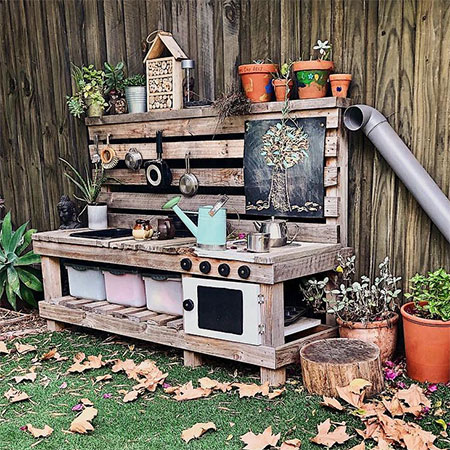
Mud kitchens are the perfect way for kids to play in the garden. We are writing a guide to the basics of a mud kitchen, including craft ideas and kitchen and accessories to buy.
This complete guide to mud kitchens will help you with all the decisions you need to make when buying a mud kitchen for your child.
In addition, we will find out how and why the garden toys can be incredibly fun and helpful for your child’s development, developing their creativity and imagination, as well as strengthening their connection with nature and enjoying nature.
Here we collected ideas for the complete guide to mud kitchens to help you decide which one to buy, and have listed all the accessories and equipment you might need. We’ve rounded up our best ideas for projects, recipes and crafts and give tips on how to stay safe while playing.
What is a mud kitchen?
In its purest form, the mud kitchen is an outdoor play area where children can pretend to cook food using any combination of mud, sand, and water.
In addition to the dirt itself, there will be a work surface, shelves or cabinet space, as well as a stove or oven for baking. To keep your kitchen looking realistic, you can also use bowls, pots and pans and tools for cooking, cooking and serving.
Moreover, the design of a mud kitchen is limitless. However, the most loved and used kitchens will be far from perfect or untouched.
How can a mud kitchen benefit children?
Learning through play couldn’t be more hands-on than the mud kitchen, which offers many benefits for a child’s physical and personal development. Exploring natural materials in a realistic setting is both fun and educational.
Along with the benefits of role-playing, adult simulation, and culinary love education found in any play kitchen, the addition of sensory materials such as dirt and sand takes the experience to the next level.
Mud kitchens stimulate creativity and imagination and provide fun and valuable play for children of all ages. Children between the ages of one and seven will get the most out of the mud kitchen, but older children are likely to enjoy it too.
Academic subjects come into play – mathematical literacy through counting, measuring and weighing, and literacy through reading and writing recipes, shopping lists and menus.
They will practice the basics of chemistry, biology and physics as they play, discover and experiment with different materials and learn to identify creatures, plants and minerals.
One child needs to play alone for hours in the kitchen – he will build confidence and self-esteem, as he does and does. Playing with siblings and friends includes teamwork and role-playing, communication, negotiation, and exchange.
Which mud kitchen accessories you need?
Aprons and overalls
Outdoor aprons are great for protecting clothing in the summer, while waterproof overalls or puddle jumpsuits will keep your baby clean, dry, and warm during the winter months. Rubber boots are ideal all year round and also protect the little toes from injury. Aprons and mud poppies are available in a variety of colours, as well as other great mud supplies such as mud boards and personalized wooden spoons. However, your od kitchen stuff will also be good.
Watering can
A watering can is the only source of water, but it will also help your child water the plants and whatever they grow.
There are many bright and colourful kids sizes available in both plastic and traditional galvanized metal. Alo you can make your own design from recycled plastic or do the watering can from bottles and a range of non-ferrous materials, like glass or old clay teapot.
Flower pots
Adding flower pots to your mud kitchen allows your child to do many interesting things: grow plants in their mud, strengthening the bond between the soil and the food we eat, hide some toys. The colourful set of 10 hanging flower pots will nicely decorate your mud kitchen or nearby fence. They are also great for storing ingredients.
Mud Kitchen Stuff
The chalkboard comes in handy for menus and recipes. It can be integrated into your mud kitchen, and some can include freestanding boards or easels. Don’t forget writing crayons, they are both good for kitchens drawing and cooking. Your child can also crush them with a pestle and mortar to add colour to sand or dirt.